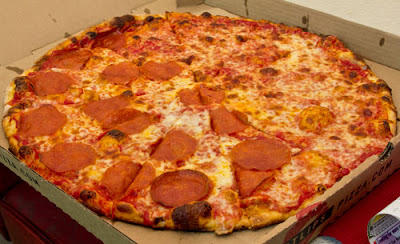2727 NE Glisan St.
Portland, OR 97232
(503) 239-4444
 |
| [Photographs: Adam Lindsley] |
Typically, using the words “cornmeal” and “pizza” in the
same sentence is a surefire way to send my attention scurrying elsewhere. It
isn’t that I dislike deep-dish pizza, it’s just that I’ve never had one that I
thought was anywhere near comparable in quality to pizza made with a dough of
traditional wheat flour and yeast. Part of the problem comes with comparing the two in
the first place, the crowbar separation between conventional pizza and
deep-dish pies--particularly those of the Chicago persuasion--and the
generalization of lumping it all together. And while Dove Vivi doesn’t
revolutionize cornmeal crust pizza, it takes it in a direction that, for the
most part, I find preferable to most deep-dish gut bombs and their ilk.
Perhaps the most important distinction between a regular
cornmeal crust pizza and the crust served at Dove Vivi is that Dove Vivi’s
crust is not, in fact, strictly cornmeal. Rather, it’s a blend of cornmeal and
Shepherd’s Grain wheat flour, well-salted and buttery in flavor.
It’s a great crust. And it should be, given that owners
Gavin and Delane Blackstock are the third generation to make use of it; it has
been passed down to them after serving time in San Francisco’s Vicolo and
L.A.’s Zelo restaurants. Dove Vivi parbakes over 100 of them (which start out
as 19-ounce balls of dough) in an oven cranked to 600 degrees ahead of the
dinner hour, as you can see when you walk in the door:
Those beauties then get baked for up to 15 additional
minutes when the toppings are piled in. The result has the soft, chewy interior
of homemade shortbread and the crunchy exterior of cornbread cooked in a
cast-iron skillet. It doesn’t crumble like cornbread, though, maintaining its
structure and withstanding the not-insubstantial payload of toppings admirably.
So now that we’ve established that this is a crust worthy
of your time, what about what goes in the crust? Is that any good? Well, it
really depends on the pizza.
What sounded great on paper but didn’t come off nearly as
well as I’d hoped was the Sausage & Peppers pizza (all pizzas are 12” and
are priced at $4.25/slice, $11.50/half, $22.50/whole). For this pie, Dove Vivi
fills that wonderful crust with aged mozzarella, house-made fennel sausage,
caramelized onions, marinated green peppers, and tomato sauce. I wasn’t kidding
when I said it sounded great, was I?
Unfortunately, the pie, as prepared on this visit, wanted for flavor. The large,
bright red hunks of tomato that comprised the “sauce” were heavily herbed and
had a stewed quality to them, but I was surprised to find that they really
didn’t taste like much. It felt as though everything about the flavors in the tomatoes--the
acidity, the brightness, even the herbs--had been toned down. Same goes for the sausage, which despite the ample
presence of fennel seeds could barely shout over the competing toppings. The
onions, when plucked and eaten separately from the slice, had a nice softness
and mild sweetness to them, but caramelized they were not; more like heavily
sweated (see the fennel sausage & onions pizza at Ken's for properly
caramelized onions). I liked that the green peppers were marinated to lessen both the crunch and the sometimes-too-bitter-for-me overtones of raw green
peppers, but yet again, there just wasn't much flavor there.
The same could not be said for the Goat Cheese pizza,
which got just about everything right. Goat cheese and mozzarella comprised the
bulk of the toppings, and while that sounds like the very definition of rich
& heavy, it wasn’t overwhelmingly so. Sure, there’s quite a lot of goat
cheese on each of these slices, but it pairs very well with the crust and its
richness is cut by the acids in the huge slab of marinated tomato resting over
the slice. That tomato triumphed where the tomato “sauce” on the Sausage &
Peppers pizza failed: it was juicy, bright, and a little sweet. A
better foil for thick, creamy goat cheese you couldn’t ask for. The marinated
green peppers made a second appearance here, bringing only the same muted
flavors they brought to the Sausage & Peppers pizza, but the addition
of rosemary was a subtle touch that added some complexity to this pizza’s
flavor profile.
This is hearty, hearty pizza, about half the thickness of
Chicago-style pizza but just as filling (two slices will do most people in). I
appreciate the way Dove Vivi embraces unusual toppings, because let’s be
honest, this is unusual pizza that probably won’t scratch your “pizza itch,”
although it is certainly satisfying. I for one am looking forward to returning
for the pie with fresh sweet corn and smoked mozzarella.
OVEN: Gas
RECOMMENDED: Goat Cheese pizza














































